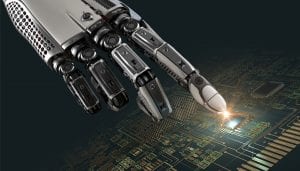Smart RPA is Risk Intelligent RPA™
Blog post
Share
 From Leonardo da Vinci sketching humanoid robots to the introduction by General Motors in the early Sixties of Unimate, the world’s first industrial robot, the vision of robotics has evolved immensely over the years.
From Leonardo da Vinci sketching humanoid robots to the introduction by General Motors in the early Sixties of Unimate, the world’s first industrial robot, the vision of robotics has evolved immensely over the years.
Today, we have entered a period where robotics continues to expand across our everyday lives, automating the low-value, menial tasks so we can spend our time focused on high value-added activities. The concept of robotic process automation (RPA) becomes even more intriguing as we consider it in the context of the finance function, specifically the Record to Report (R2R) process. Research from McKinsey & Company recently states, “About 20% of the tasks of a typical finance unit’s Record to Report (R2R) process are fully automatable (requiring no human intervention) and nearly 50% are mostly so (with technology undertaking most of the work).” So, what is RPA, how does it affect the financial close process and how are other companies currently utilizing RPA to transform their financial close?
Simply put, basic RPA automates menial and straightforward manual tasks, freeing finance staff to focus on becoming strategic accountants that drive the business forward. However, although a basic RPA approach can increase your efficiencies by reducing these simplistic, manual tasks, it is not a sufficient approach to support an end goal of ensuring the integrity of the period end numbers. What is needed to drive strategic change is an approach that not only increases efficiencies, but also effectiveness.
Risk Intelligent Robotic Process Automation
Taking RPA one step further, Trintech has defined Risk Intelligent RPA (RI RPA) as using RPA within a defined risk-based, risk-intelligent framework that automatically enforces business rules. RI RPA looks to optimize the process, so that users can go beyond balancing the workload and eliminating manual work, to analyzing the data and applying creative intelligence to tasks such as problem solving and evolving the business. This not only delivers improved value to the business, but is also the type of high value work most likely to attract and retain high quality people.
For example, in terms of reconciliations, a key function in the financial close process, we tend to spend most of our time simply gathering data before we can even begin to think about reconciling it. Once the data is finally in the right format, most of our time is then spent manually going through the matching process, rather than spending that time focused on the areas that are most critical to us. RI RPA ensures we spend the majority of our time in the world of exceptions. Our priority is to focus on identifying core issues, as to the reasons for the exceptions, and identifying potential initiatives to improve the process so these exceptions decrease over time. By inputting it through an RI RPA workflow, you can also push the exceptions through discovery, research and resolution, bringing it back to a single view where all financial statements are being reconciled. This leads to a focus on what is important, rather than just simply providing data.
Furthermore, with RI RPA, an effective controls framework underpins the whole financial process and, by unifying all key control components together, it enables a clear audit trail for compliance initiatives. To drive further efficiencies, RI RPA can be utilized not only to lower costs and reduce errors, but also to improve compliance by inspecting, automating and triggering remediation. This provides companies with a way to achieve better financial governance overall.
Below are some real-life examples of ways that robotics is transforming finance functions around the world and how companies have benefited from moving processes in the direction of RI RPA:
Trintech Customer: US $30 Billion+ Sports Equipment Company
One of our enterprise-class customers enabled automation of risk-based schedule changes, which replaced a very time-consuming, manual process. These changes are now able to be applied monthly rather than annually, increasing the overall efficiency by reducing the frequency of reconciliation of lower-risk accounts.
Trintech Customer: US $20 Billion+ Pharmaceutical Company
Another one of our enterprise-class customers implemented dynamic rules to identify low-risk accounts and simply auto certifies/eliminates them from the month-end process. This has optimized the process so that users only perform high-risk/high-value activities.
By leveraging technology coupled with a RI RPA approach, you can effectively manage the entire financial close process in one place, with a single view of all relevant controls. With this increased standardization, you can start to establish metrics that are comparable across your business, whether by corporate entity, location or shared services. Whether you have automated some or all of your processes, it is evident that robotics, most specifically RI RPA, will drive positive change across your organization.
To learn more about Risk Intelligent RPA, download our R2R Insights Piece, “Moving from Continuous Accounting to Risk Intelligent RPA.”
Written by: Kelli Shoevlin


